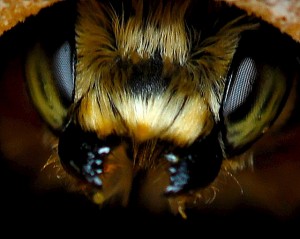The Silence of the Bees
Podcast: Play in new window | Download

To be a bee, or not to be a bee, that is the question when the colony is about to collapse. (Photo by Doug88888.Flickr)
This is how the media deal with stories such as bee-colony collapse disorder. It is as if, on day one, they sight a forest fire approaching the city and begin to air breathless bulletins containing little information and wild speculation bout how bad it might get. On day two, the fire being bigger and closer, they go to wall-to-wall coverage and talk of nothing else. On day three, the fire is even bigger and even closer, but it’s old news. Back to celebrity divorces. Thus has the prospect of losing our honeybees — and one third of our food — dropped from the public radar.
Colony Collapse Disorder got its name and its acronym — CCD — in 2007, after entire colonies of bees began to disappear. The first reports of losses came from commercial beekeepers whose workers spent much of their lives on 18-wheeler trucks being whisked from one farm to another to pollinate on the the 70-plus crops that depend on bees for their survival. The syndrome — a sudden and virtually complete disappearance of an entire colony of bees — spread across North America and Europe.
During the panicky coverage of the problems affecting commercial beekeepers it was noticed that wild bees in the affected areas were virtually extinct.
Media coverage reached a fever pitch in 2010, during which year any number of “causes” of the disorder were announced. It was mites! No, a fungus! No, cell phone radiation! An influenza? Pesticides? Starvation! Habitat destruction! Genetically modified crops? Genetically modified bees!
Alas, none of the vaunted “causes” stood up to investigation as the prime culprit. In the absence of a simple answer, and of a change in the story (year after year, 30% of the bees vanish), the media went back to the ever-reliable Kardashians and left the world to assume that somehow the problem has been solved, or has gone away.
Not so. The bees continue to vanish. The threat to the world’s food supply continues to grow. But like the imaginary forest fire that is bigger and closer, it’s old news.
Not to the people who make their livings from bees, and the plants they pollinate. Those folks met last week in another desperate attempt to define what they are facing and how to deal with it — and to enlist public awareness, concern and action. (Probably not helpful to the latter part of their cause: they met in Las Vegas.) Think this characterization of the urgency is overblown? Consider the case of Steve Ellis. He has been a beekeeper for most of his life, and is secretary of the National Honey Bee Advisory Board, a participant in last week’s conference. So many of his bees vanished last year that he is eligible for federal disaster relief.
The conference got little attention, partly because the disappearance of the bees is old news, and partly because the people most involved in and knowledgeable about the problem see no simple cause or easy fix. That is most likely because, as is the case with all the other problems that assail our besotted culture these days, there are no simple causes or easy fixes.
More than likely, all the causes identified above contribute to the stress on bees, and when you relentlessly increase a variety of stresses, you eventually reach a breaking point. The assaults of industrial agriculture, urban development, genetic engineering, and yes, the “management” inflicted on them by commercial beekeepers, have turned up the dials of destruction on the hapless little pollinators until they have reached the point of collapse. The only thing that could save them is a systemic change that would cost the people who are killing the bees a lot of money. So that’s not going to happen.
Look around you. Add up the stresses. Your colony is next.







No comments:
Post a Comment